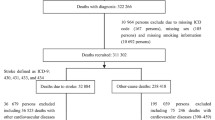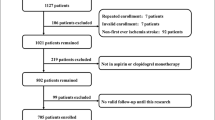Summary
Continued smoking following stroke is associated with adverse outcomes including increased risk of mortality and secondary stroke. The aim of this study was to examine the long-term trends in smoking behaviors and factors associated with smoking relapse among men who survived their first-ever stroke. Data collection for this longitudinal study was conducted at baseline through face-to-face interviews and follow-up was completed every 3 months via telephone, beginning in 2010 and continuing through 2014. Cox proportional hazard regression models were used to identify predictors of smoking relapse behavior. At baseline, 372 male patients were recruited into the study. Totally, 155 (41.7%) of these patients stopped smoking for stroke, and 61 (39.3%) began smoking again within 57 months after discharge with an increasing trend in the number of cigarettes smoked per day. Exposure to environmental tobacco smoke at places outside of home and work (such as bars, restaurants) (HR, 2.34; 95% CI, 1.04–5.29, P=0.04), not having a spouse (HR, 0.12; 95% CI, 0.04–0.36; P=0.0002) and smoking at least 20 cigarettes per day before stroke (HR, 2.42; 95% CI, 1.14–5.14, P=0.02) were predictors of smoking relapse. It was concluded that environmental tobacco smoke is an important determinant of smoking relapse among men who survive their first stroke. Environmental tobacco smoke should be addressed by smoke-free policies in public places.
Similar content being viewed by others

References
Wei C, Zhang F, Chen L, et al. Factors associated with post-stroke depression and fatigue: lesion location and coping styles. J Neurol, 2016,263(2):269–276
Wang CJ, Wang YL, Li ZX, et al. The management of ldl cholesterol and predictors of goal achievement in stroke patients in China: A cross-sectional study. CNS Neurosci Ther, 2016,22(7):577–583
Wu X, Zhu B, Fu L, et al. Prevalence, incidence, and mortality of stroke in the Chinese island populations: a systematic review. PloS One, 2013,8:e78629
Wang Y, Cui L, Ji X, et al. The China National Stroke Registry for patients with acute cerebrovascular events: design, rationale, and baseline patient characteristics. Int J Stroke, 2011,6(4):355–361
Wijk IV, Kappelle LJ, Gijn JV. Long-term survival and vascular event risk after transient ischemic attack or minor ischemic stroke: A cohort study. Lancet, 2005,365(9477):2098–2104
Hankey GJ. Long-term outcome after ischaemic stroke/transient ischaemic attack. Cerebrovasc Dis, 2003,16(Suppl. 1):14–19
Kernan WN, Ovbiagele B, Black HR, et al. Guidelines for the prevention of stroke in patients with stroke and transient ischemic attack: a guideline for healthcare professionals from the American Heart Association/ American Stroke Association. Stroke, 2014,45(7):2160–2236
Béjot Y, Jacquin A, Daubail B, et al. Smoking status and severity of ischemic stroke. A population-based study. Eur Neurol, 2014,71(1–2):59–64
Lubin JH, Couper D, Lutsey PL, et al. Risk of cardiovascular disease from cumulative cigarette use and the impact of smoking intensity. Epidemiology, 2016,27(3):395–404
Bullen C. Impact of tobacco smoking and smoking cessation on cardiovascular risk and disease. Expert Rev Cardiovasc Ther, 2008,6(6):883–895
Burns DM. Epidemiology of smoking-induced cardiovascular disease. Prog Cardiovasc Dis, 2003,46(1):11–29
Erhardt L. Cigarette smoking: an undertreated risk factor for cardiovascular disease. Atherosclerosis, 2009,205(1):23–32
Wolf PA, D’Agostino RB, Kannel WB, et al. Cigarette smoking as a risk factor for stroke: The framingham study. JAMA, 1988,259(7):1025–1029
Redfern J, McKevitt C, Dundas R, et al. Behavioral risk factor prevalence and lifestyle change after stroke: a prospective study. Stroke, 2000,31(8):1877–1881
Bak S, Sindrup SH, Alslev T, et al. Cessation of smoking after first-ever stroke: a follow-up study. Stroke, 2002,33(9):2263–2269
McBride CM, Clipp E, Peterson BL, et al. Psychological impact of diagnosis and risk reduction among cancer survivors. Psychooncology, 2000,9(5):418–427
Ives SP, Heuschmann PU, Wolfe CD, et al. Patterns of smoking cessation in the first 3 years after stroke: the South London Stroke Register. Eur J Cardiovasc Prev Rehabil, 2008,15(3):329–335
Sienkiewicz-Jarosz H, Zatorski P, Baranowska A, et al. Predictors of smoking abstinence after first-ever ischemic stroke: a 3-month follow-up. Stroke, 2009,40(7):2592–2593
McCarthy MJ, Huguet N, Newsom JT, et al. Predictors of smoking patterns after first stroke. Soc Work Health Care, 2013,52(5):467–482
Suner-Soler R, Grau A, Gras ME, et al. Smoking cessation 1 year poststroke and damage to the insular cortex. Stroke, 2012,43(1):131–136
Hughes JR, Keely J, Naud S. Shape of the relapse curve and long-term abstinence among untreated smokers. Addiction, 2004,99(1):29–38
Choi-Kwon S, Kwon SU, Kim JS. Compliance with risk factor modification: early-onset versus late-onset stroke patients. Eur Neurol, 2005,54(4):204–211
Acquavita SP, McClure EA, Hargraves D, et al. Environmental tobacco smoke exposure among smokers and non-smokers receiving outpatient substance abuse treatment. Addict Behav, 2014,39(12):1718–1722
Pizacani BA, Martin DP, Stark MJ, et al. A prospective study of household smoking bans and subsequent cessation related behaviour: the role of stage of change. Tob Control, 2004,13(1):23–28
Hyland A, Higbee C, Travers MJ, et al. Smoke-free homes and smoking cessation and relapse in a longitudinal population of adults. Nicotine Tob Res, 2009,11(6):614–618
Farkas AJ, Gilpin EA, Distefan JM, et al. The effects of household and workplace smoking restrictions on quitting behaviours. Tob Control, 1999,8(3):261–265
Janson C, Künzli N, de Marco R, et al. Changes in active and passive smoking in the European Community Respiratory Health Survey. Eur Respir J, 2006,27(3):517–524
Investigators WMPP. The World Health Organization MONICA Project (monitoring trends and determinants in cardiovascular disease): a major international collaboration. J Clin Epidemiol, 1988,41(2):105–114
Tse LA, Fang XH, Wang WZ, et al. Incidence of ischaemic and haemorrhagic stroke and the association with smoking and smoking cessation: a 10-year multicentre prospective study in China. Public Health, 2012,126(11):960–966
Li Q, Hsia J, Yang G. Prevalence of Smoking in China in 2010. N Engl J Med, 2011,364(25):2469–2470
Bonevski B, Paul C, Jones A, et al. Smoky homes: gender, socioeconomic and housing disparities in second hand tobacco smoke (SHS) exposure in a large population-based Australian cohort. Prev Med, 2014,60:95–101
Eng L, Su J, Qiu X, et al. Second-hand smoke as a predictor of smoking cessation among lung cancer survivors. J Clin Oncol, 2014,32(6):564–570
Ballard J, Kreiter KT, Claassen J, et al. Risk factors for continued cigarette use after subarachnoid hemorrhage. Stroke, 2003,34(8):1859–1863
Tofler GH, May R, Bartrop R, et al. Acute coronary syndrome as a teachable moment for smoking cessation. J Smoking Cessation, 2013,10(1):5–11
Ockene JK, Emmons KM, Mermelstein RJ, et al. Relapse and maintenance issues for smoking cessation. Health Psychol, 2000,19(1 Suppl):17–31
Killen JD, Fortmann SP. Craving is associated with smoking relapse findings from three prospective studies. Exp Clin Psychopharmacol, 1997,5(2):137–142
Prugger C, Wellmann J, Heidrich J, et al. Passive smoking and smoking cessation among patients with coronary heart disease across Europe: results from the EUROASPIRE III survey. Eur Heart J, 2014,35(9):590–598
Fichtenberg CM, Glantz SA. Effect of smoke-free workplaces on smoking behaviour: systematic review. BMJ, 2002,325(7357):188
Brownson RC, Hopkins DP, Wakefield MA. Effects of smoking restrictions in the workplace. Annu Rev Public Health, 2002,23:333–348
Bauer JE, Hyland A, Li Q, et al. A longitudinal assessment of the impact of smoke-free worksite policies on tobacco use. Am J Public Health, 2005,95(6):1024–1029
Albertsen K, Hannerz H, Borg V, et al. Work environment and smoking cessation over a five-year period. Scand J Public Health, 2004,32(3):164–171
Yan. Yang, Heng. Jiang, Xi. Wu. Analysis of policies on banning smoking in public places and their implementation in China. Zhongguo Jiankang Jiaoyu (Chinese), 2008,24(9):657–669
Li Yx, Jiang Y, Yan. Yang, et al. Current situation of law and regulation for banning smoking in public places in China. J Environ Health, 2007,24:221–223
Mishra SI, Osann K, Luce PH. Prevalence and predictors of smoking behavior among Samoans in three geographical regions. Ethn Dis, 2005,15(2):305–315
Brothers BM, Borrelli B. Motivating Latino smokers to quit: does type of social support matter? Am J Health Promot, 2011,25(5 Suppl):S96–102
Acknowledgments
We would like to thank Bryan Bassig for writing and editing assistance and helpful suggestions.
Author information
Authors and Affiliations
Corresponding author
Additional information
This project was supported by National Natural Science Foundation of China (No. 30600511).
Rights and permissions
About this article
Cite this article
Hou, Ls., Du, Xd., Li, Jj. et al. Long-term trends and predictors of smoking behaviors among men following first-ever ischemic stroke. J. Huazhong Univ. Sci. Technol. [Med. Sci.] 37, 446–452 (2017). https://doi.org/10.1007/s11596-017-1755-3
Received:
Revised:
Published:
Issue Date:
DOI: https://doi.org/10.1007/s11596-017-1755-3



